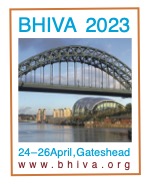No vertical HIV transmissions in the UK from women eligible for supported breastfeeding
1 August 2023. Related: Conference reports, Pregnancy, Paediatric care, BHIVA 29th Gateshead 2023.
 Polly Clayden, HIV i-Base
Polly Clayden, HIV i-Base
There were no vertical transmissions in the UK among women living with HIV supported to breastfeed from 2012 to 2021 – according to data presented at the BHIVA spring conference 2023. [1]
These cases are small but increasing. Although the results to date are very reassuring, some infants were lost to follow up or still in follow-up during the monitoring period.
The current rate of vertical transmission from women in the UK diagnosed with HIV is less than 0.3%. BHIVA recommends formula-feeding to eliminate the risk of post-natal transmission. But the guidelines also say that women who are virologically suppressed on ART with good adherence may be supported to breastfeed (supported breastfeeding).
Since 2018, BHIVA guidelines for supported breastfeeding have included:
- Monthly review in clinic and viral load testing for mother and baby during the breastfeeding period and for two months after cessation
- Maternal ART rather than infant pre-exposure prophylaxis.
- Breastfeeding for as short a time as possible, exclusively for the first six months, and recommendation to stop if: signs of breast infection/mastitis, gastrointestinal symptoms in mother or infant, or blip in maternal viral load.
- Infant HIV antibody testing for seroconversion at 22 to 24 months of age, or at a minimum of eight weeks after cessation of breastfeeding if this is later.
The study objective was to describe the characteristics and clinical monitoring of BHIVA supported breastfeeding among women living with HIV in the UK in the period 2012 to 2021.
The Integrated Screening Outcomes Surveillance Service (ISOSS) conducts surveillance of all pregnancies to diagnosed women living with HIV in the UK.
There were 267 reports of intention to breastfeed and/or supported breastfeeding. Commonly reported reasons were: bonding (69%), health benefits (60%), disclosure concerns (26%), previous breastfeeding since diagnosis (26%) and family or friends’ expectations or pressure (22%).
Among 8,513 live birth deliveries, 203 (2.4%) women were confirmed supported to breastfeed, with some breastfeeding more than one infant.
There was a four-fold increase in cases from less than 10 per year from 2012 to 2014 to 40–50 during 2019 to 2021. The majority (95%, 190/201) were in women diagnosed before pregnancy and 84.0% (170/201) were in women born abroad, with 79% (154/197) from sub-Saharan Africa.
Median maternal age was 35 years (IQR: 31 to 40). Breastfeeding duration ranged from one day to two years: median 56 days (IQR: 23 to 140).
In 46 cases, monthly testing was known not to be applicable due to breastfeeding duration. Where applicable, 80.2% (77/96) of mother-infant pairs had monthly testing according to BHIVA guidelines. In 11 cases, reasons for not having monthly testing included: scheduling miscommunications, parental requests, and long-term maternal virological suppression. Attendance issues were reported in 32.5% (25/77) of cases with monthly testing.
For most women, cessation of breastfeeding was part of a plan to stop. But in 10 cases, breastfeeding was stopped due to maternal viral load rebound.
Of 150 infants, 106 had a negative antibody result at 18 months of age or older, five were discharged based on negative antibody result dated less than 18 months, 34 were awaiting confirmatory testing and five were lost to follow-up.
Presenting author Rebecca Sconza noted that supported breastfeeding is varied in both duration of breastfeeding and attendance for monthly testing.
comment
There is a lack of evidence to recommend breastfeeding among women with HIV in high-income countries, so these data are welcome. Although BHIVA primarily recommends formula feeding, there has been guidance for supported breastfeeding since 2018 in the UK.
In January 2023, US guidance was updated to include breastfeeding for the first time. [2]
Similar to BHIVA, the panel recommends: “Individuals with HIV who are on ART with a sustained undetectable viral load and who choose to breastfeed should be supported in this decision”.
The extremely small numbers of documented cases from high-income countries is notable in the panel’s data summary. Case series cited from Germany, Italy, US and Canada include as few as three breastfed, HIV-free infants and only as many as 30.
Continual monitoring and documentation of supported breastfeeding management and vertical transmission outcomes is essential – both in this country and other high-income settings – to support future guidelines and safe infant feeding for women living with HIV who choose to do so.
Reference
- Francis K et al. Monitoring clinical practice of BHIVA-supported breastfeeding guidelines for women living with HIV in the UK. BHIVA 2023 spring conference. Gateshead, UK. 24–26 April 2023. Oral abstract O12.
https://www.bhiva.org/file/645ba42b0e61f/O12.pdf (pdf) - US National Institutes of Health. Infant feeding for individuals with HIV in the United States. 31 January 2023.

